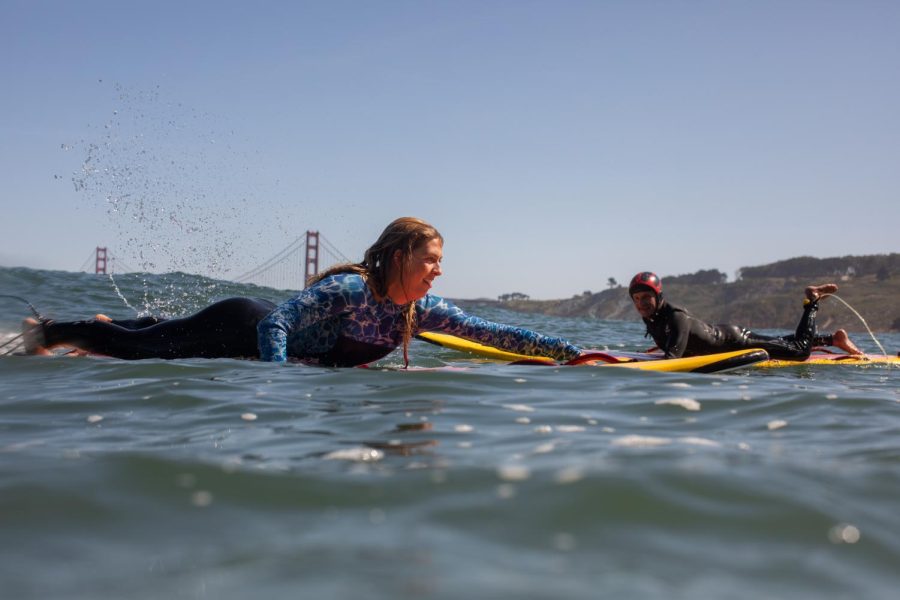‘When in Doubt, Don’t Go Out’
The San Francisco coastline is notorious for perilous conditions, and this can result in dire consequences for those not adhering to beach safety protocols.
Ocean Rescue Lifeguard Jacqueline Racich paddles for a wave while fellow lifeguard Sean Scallan goes back out to the line up at China Beach. Scallan and his team work to identify dangerous rip currents and deploy for rescue operations using jet skis, surfboards and swimming fins. (Benjamin Fanjoy / Xpress Magazine)
Welcome to any San Francisco beach — water too cold for casual swimming, wind gusts strong enough to burn cheeks and currents strong enough to sweep one off their feet. The coastline of San Francisco and its neighboring cities aren’t for the casual beachgoer. If you’ve spent time at the sandy dunes of Ocean Beach or relaxed under the cliffs of Funston Beach, you might have noticed how quickly conditions can change. Wind can pick up dramatically, and in turn, the strength of the tide can increase. Any beachgoer, whether a lifelong surfer or a casual wader, is susceptible to the perils of the sea.
In January, SF State senior Hamzah Alsaudi was out in nearby Pacifica with members of the university’s wrestling team when he was swept out to sea — he has yet to be found.
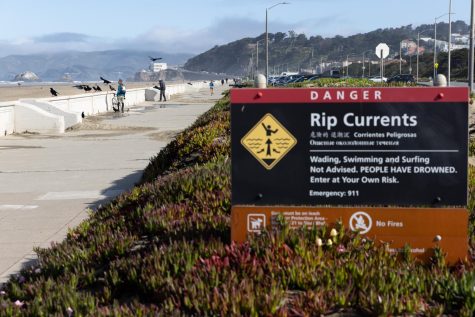
“When in doubt, don’t go out” is a refrain of many surfers when it comes to facing the surf. Regular surfers come to know about the hazards of the ocean. They typically learn to face rip currents and other ocean-borne perils, from “sneaker waves” to severe water temperatures. However, the average beachgoer may not have this experience, which can lead to tragic consequences.
According to 2023 data published by the California Department of Parks and Recreation, drowning continues to be the highest cause of accidental death in state parks. Additionally, approximately 50% of the nation’s population are non-swimmers, meaning they cannot swim or lack basic swimming skills.
Ocean Beach is home to three miles of vast coastline, with tides going in and out under the Golden Gate Bridge four times a day, according to Sean Scallan, a lifeguard at the beach.
“We have all of the bay water pouring out of the narrow opening by the Golden Gate Bridge,” Scallan said. “This creates a lot of current up and down, especially on high snow and rainfall years like this year.” The current goes around the corner by the Cliff House Restaurant and travels south in an outgoing tide. “The water comes pouring out under the Golden Gate like a giant river, creating stronger currents,” Scallan said. “This water is also at colder temperatures because of all the snow melt from this year.”
Ocean Beach did not have lifeguards in place until 1998, when there were seven drownings that year alone.
“This was the most dangerous beach in the whole nation, which includes Hawaii and Alaska,” Scallan said. “Seven drownings here, which makes up for 10% of all ocean drownings in California.”
Spring is the worst season at Ocean Beach because of the windy conditions that form rip currents, according to Scallan. A rip current is defined as “a powerful, channeled current of water flowing away from shore,” according to the National Park Service. Additionally, Ocean Beach sees more visitors during this time, due in part to spring break and schools getting out for summer.
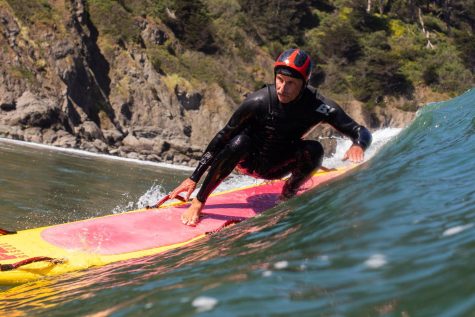
“You got people coming out here in droves, and they want to get in the water but the rip currents are bad,” Scallan said. “The rip currents are more defined, active and stronger in the spring, and they pull faster outward.” Scallan often sees beachgoers get caught in riptides and quickly moves in to rescue them.
Grant Washburn, an instructor at Big Wave Risk Assessment Group (BWRAG) and a Mavericks surfing legend and filmmaker, has spent decades surfing and studying big waves.
“Besides rip currents, major hazards on our coast are the ‘sneaker sets,’ the strong currents and the low water temperature,” Washburn said. “Sneaker sets” and “sneaker waves” are unusually large waves that are taller, stronger and move farther up the shore to levels way beyond the reach of normal waves. “It may seem surprising, but many of the rescues and drownings occur on calmer days that are nice and warm,” Washburn said.
A common scenario Washburn sees is a beachgoer looking at a deceptively inviting day on the beach, getting caught by a surge of powerful waves and being swept out into deeper water.
“Even a strong swimmer will be in trouble in a few minutes due to the water temperature,” Washburn said. “A good wetsuit is critical here, and without one, you need to be extremely careful. There is little time to act.”
Washburn was part of a UC Berkeley study where a small group of researchers wore GPS trackers and jumped into a deadly rip current at Ocean Beach.
“Rip currents behave like mushroom clouds growing off of the beach, with the strongest flow in the center of the stem,” Washburn said. “But like pouring cream in coffee, there are variables in the turbulence.” According to Washburn, if you throw several people into the center of this current, some will get moved aside or caught in an eddy and spun back. “Only a few will get pushed the most, and sucked away the fastest,” he explained. “If you are in such a spot, swimming in will not work. You go backwards.” The strategy to utilize is to assess your position in the current and go to one side. “Exhausting yourself on a treadmill is bad.”
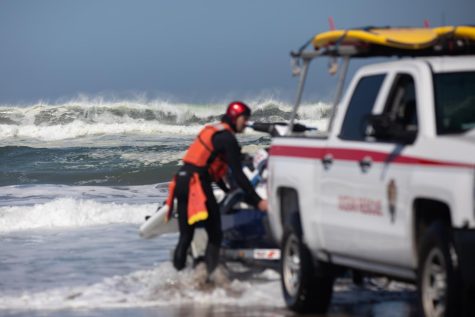
When you see someone in a rip current, it is most important to keep watching the victim and to get attention, as well as direct it, according to Washburn. “Wave like crazy with both arms overhead and when someone sees you, point one arm straight at the target,” Washburn said. “Keep waving the other hand for help to arrive.”
It is extremely important to be aware of the currents before entering the water, and all beachgoers should consult a lifeguard about this beforehand, if possible. “Disturbed, cloudy water is a sign of a current, but rip currents can be almost invisible,” Washburn said. “Often they are next to breaking waves but may have no waves in them, so they look like a good spot to swim.”
Using your best judgment on whether it is safe to enter the water is a practice vital to the average beachgoer and big-wave surfers alike. Zach Diionno, managing director of BWRAG, is a major proponent of this practice. “When you defy what your natural inclination is, in Hawaiian, we call it the ‘na’au,’” Diionno said.
One of the main goals of BWRAG is to make sure all the surfers they work with, whether highly advanced or novice riders, are properly trained to surf safely and confidently. “If you go out there not feeling confident, that’s when something bad happens,” Diionno said. “When you’re feeling unsettled and unsure, it increases the chances of an injury or something worse.”
Due to San Francisco’s location on the edge of the Pacific Ocean, it receives swells from both the north and the south, according to Washburn. This can result in the city’s beaches being frequently swept by long-period waves, which are not typically taller than the average wave but do harness more energy. “These are the ‘sneaker waves’ that drive strong currents,” Washburn said. “A storm three thousand miles away, that rages and then dies this week, can send a wave that might swamp a boat here next Friday.” Typically, these swells are not obvious because of their long lulls that make the surf appear calm, Washburn said. “Few coastlines have this exposure,” he said.

At San Francisco’s Ocean Beach, there are a total of three lifeguard patrol vehicles that work the area from 9 a.m. to 7 p.m. Scallan moves up and down Ocean Beach’s coastline for 10 hours a day, keeping a watchful eye on beachgoers and the current. Scallan uses a pair of Bushnell binoculars and refers to this process as “glassing.” “Unless you have a wetsuit and a pair of flipper fins on your feet, you should only go knee-deep in the water,” Scallan said. “The wetsuit keeps you warm and afloat, and the fins can get you swimming through the currents.” Swimmers and surfers that wear these are not particularly worrisome to Scallan, as they are typically well-versed in ocean safety.
“We’re really looking for casual people entering the water past their knees,” Scallan said. “And we whistle and safely get them out of the water to educate them on where rip currents and sandbars are. We show them where it’s safer.”
Pacifica’s coastline does not have lifeguards in place but does have a truck patrol at Pacifica State Beach, Scallan said. “Responding from far away in the truck, it’s kind of too far,” Scallan said. “It’s too late already.” Pacifica State Beach is referred to as “The Undertow” because of how quickly it gets deep. “You walk 30 feet from shore and you’re not even standing up at that beach,” Scallan said. “It’s really dangerous, and there should be more lifeguards down at that park and the whole area.”
Scallan laid out the process his lifeguard team utilizes when rescuing someone. “We put it on our radio where we’re at, where we’re going and send for backup,” Scallan said. These lifeguards utilize two different radios: the first is used to communicate with each other in their three trucks, and the second is used to contact the National Park Service dispatch, according to Scallan. These lifeguards also utilize a radio where the fire department’s 911 calls originate. “[The fire department] gets the call first and then it comes over to us through our park radio or we’ll hear it on the fire radio,” Scallan said. “We’ll tell the fire department to send for backup because we have firehouses out here in the city that are surf-certified.”
San Francisco resident and frequent beachgoer Brianne Jones is aware that the danger of the city’s beaches can extend beyond the sand. “Lots of the cliffs around Point Reyes Beach are very shaky,” Jones said. “I’ve stepped on really unstable parts of the cliff and there is a serious danger of people falling off because the cliffs could crumble under them.” Jones also recalled an instance where rocks fell from cliffs above – she stressed the importance of not standing or laying out directly under the edges.
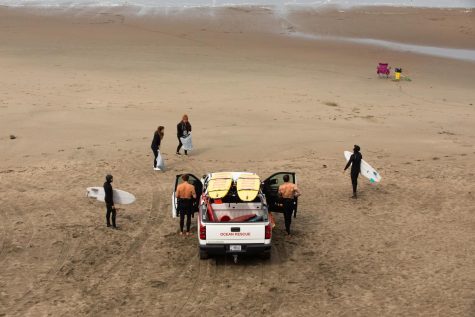
San Francisco resident and surfer Michael Sweeney grew up surfing in Pacifica and San Francisco. “I’ve had a couple close calls over the years,” Sweeney said. “It’s crazy how strong the currents can be, and super scary how they can hold you underwater.”
Explore San Francisco’s Beaches
The map displays the individual characteristics of all of San Francisco’s beaches. The information is sourced from Ocean Beach lifeguard Sean Scallan, National Park Service, presidio.gov and parksconservancy.org (David Blakeley/Xpress Magazine)

David Blakeley (he/him) is a senior reporter for Xpress Magazine. He is majoring in journalism and minoring in labor studies. He was born in Orange County,...

Benjamin Fanjoy is a San Francisco-based photojournalist. Originally from Maryland, Benjamin moved to San Francisco in the summer of 2018 after completing...


